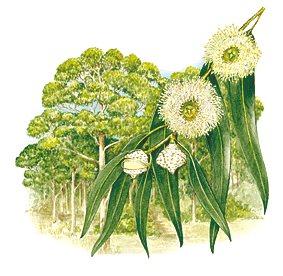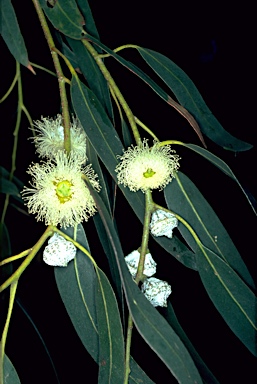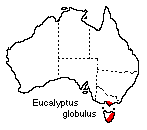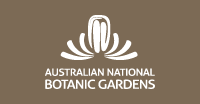 Tasmanian
Blue Gum
Tasmanian
Blue Gum
Eucalyptus globulus
(plant family: Myrtaceae)
Floral Emblem of Tasmania
The Tasmanian Blue Gum, Eucalypts globulus, was proclaimed as the floral emblem of Tasmania on 27 November 1962. [ Gazettal PDF, Official description, Official portrait ]
Eucalyptus globulus was first collected on the south-east coast of Tasmania in 1792-93 by Jacques-Julien Houtou de Labillardiere (1755-1834) and described by him in 1799. He was a distinguished French botanist who accompanied Bruny D'Entrecasteaux on the expedition in La Recherche and L'Esperance in 1791-94 in search of their missing compatriot, La Perouse. The two ships of the expedition led by La Perouse landed at Botany Bay on 26 January 1788. They departed six weeks later and forty years elapsed before their fate was established by the discovery of wreckage at Santa Cruz, north of the New Hebrides. Labillardiere was a keen collector of plants and animals and also recorded detailed accounts of the appearance and customs of the Australian Aboriginals he observed. His plant specimens are now housed in the Museum of Florence.
 Eucalyptus
globulus now includes several subspecies of which E. globulus subsp. globulus is the Tasmanian emblem. The generic name Eucalyptus is derived from the Greek 'eu', meaning 'well', and 'kalypto', meaning 'to cover,
as with a lid', referring to the operculum, a cap-like structure which protects
the stamens in the bud and is shed when the flower opens. The operculum is a
distinguishing feature of all species of Eucalyptus. The specific name globulus, from the Latin meaning 'ball-like' or 'spherical', refers to
the shape of the fruit. The genus Eucalyptus numbers about 800 species
which are widely distributed in Australia, with a few species occurring in some
of the islands to the north. It belongs to the family Myrtaceae, which is widespread
in Australia and tropical regions of the Americas.
Eucalyptus
globulus now includes several subspecies of which E. globulus subsp. globulus is the Tasmanian emblem. The generic name Eucalyptus is derived from the Greek 'eu', meaning 'well', and 'kalypto', meaning 'to cover,
as with a lid', referring to the operculum, a cap-like structure which protects
the stamens in the bud and is shed when the flower opens. The operculum is a
distinguishing feature of all species of Eucalyptus. The specific name globulus, from the Latin meaning 'ball-like' or 'spherical', refers to
the shape of the fruit. The genus Eucalyptus numbers about 800 species
which are widely distributed in Australia, with a few species occurring in some
of the islands to the north. It belongs to the family Myrtaceae, which is widespread
in Australia and tropical regions of the Americas.
Tasmanian Blue Gum is a tall, straight tree growing to 70 metres in height and 2 metres in trunk diameter under favourable conditions. The rough, deeply furrowed, grey bark is persistent at the base of the trunk but above this level it is shed in strips leaving the branches and the greater length of the trunk smooth-barked. The broad juvenile leaves, borne in opposite pairs on square stems, are about 6 to 15 cm long and covered with a blue-grey, waxy bloom. This is the origin of the common name 'blue gum'. The mature leaves are narrow, sickle-shaped and dark shining green. They are arranged alternately on rounded stems and range from 15 to 35 cm in length. The buds are top-shaped, ribbed and warty and have a flattened operculum bearing a central knob. The cream flowers are borne singly in the leaf axils and produce copious nectar which tends to yield a strongly flavoured honey. The woody fruits range from 1.5 to 2.5 cm in diameter. Numerous small seeds are shed through valves which open on the top of the fruit.
 Eucalyptus
globulus subsp. globulus occurs in tall open forest in south-eastern
Tasmania and to a lesser extent along the eastern coast of the State. It also
occurs on King and Flinders Islands in Bass Strait. Outside Tasmania it is confined
to Wilson's Promontory and the Cape Otway district in southern Victoria. The
climate throughout its range is cool to mild, with wet winters and reliable
summer rainfall. Within parts of its range, light frosts and snowfalls occur.
Eucalyptus
globulus subsp. globulus occurs in tall open forest in south-eastern
Tasmania and to a lesser extent along the eastern coast of the State. It also
occurs on King and Flinders Islands in Bass Strait. Outside Tasmania it is confined
to Wilson's Promontory and the Cape Otway district in southern Victoria. The
climate throughout its range is cool to mild, with wet winters and reliable
summer rainfall. Within parts of its range, light frosts and snowfalls occur.
Tasmanian Blue Gum is protected in conservation areas such as Maria Island National Park, Freycinet National Park, Tasman Arch Nature Reserve and St Mary's Pass Nature Reserve. Outside State reserves it occurs in reserves managed by the Department of Lands and the Forestry Commission. Both authorities have regulations prohibiting the taking of native flora from Crown Land and State forests respectively without prior permission of the managing authority.
Being a very tall evergreen tree Tasmanian Blue Gum is unsuitable for cultivation in the average home garden but it can be recommended as a handsome subject for parks and large gardens in regions which do not experience severe frosts. It is easily propagated from seeds. In subtropical horticulture it has enjoyed popularity as a bedding plant, with freshly raised seedlings being planted each year. Its horticultural value lies in the unusual effect achieved by the colour and form of the juvenile foliage. It is grown successfully in large gardens in Cornwall, where the cool to mild, damp climate is favourable.
The flowers are usually inaccessible and so they are seldom available for indoor decoration. The large blue-grey juvenile leaves are ideal as backing material in floral arrangements in which an unusual colour effect and bold form are desired. Either fresh or dried foliage may be used. Both emit the distinctive eucalyptus fragrance so evocative of the Australian bush.
Tasmanian Blue Gum yields pale, hard and durable timber which is used in Australia for poles, piles and sleepers. The species has been widely planted in New Zealand, South Africa, South America, California, India and Mediterranean countries, in farm windbreak, forestry and ornamental plantations. Among the qualities admired overseas are its rapidity of growth, straightness of trunk, strength of wood and adaptability to a range of sites. Originally overseas plantations supplied antiseptic oil, fuel, telegraph poles, mine props and construction timber. In addition they now provide pulpwood for paper and rayon manufacture. It has also contributed to the drainage of swamps in malarial localities in central Africa, Italy and Turkey. Before the role of the malarial mosquito in spreading the disease was understood, there was a superstitious belief that the leaves of the Blue Gum released a magical essence which purified the air of fever germs. In reality the benefit is derived from the loss of suitable breeding sites for mosquitoes, brought about by the capacity of the trees to evaporate water from the swampy ground.
Tasmanian Blue Gum is so abundant in coastal areas of California that many people assume it is a native species. In recent years concern has been expressed that it appears to be becoming naturalised. Studies show that there is a tendency for it to spread from plantations by seed dispersal along drainage lines but it is doubtful that it will ever become troublesome.
It was featured on a 15 cent stamp [illust] issued on 10 July 1968 as part of a set of six stamps depicting State floral emblems. The stamp was designed by Dorothy Thornhill.
Although Tasmanian Blue Gum is the official floral emblem it seems to be seldom used for either official or popular purposes. This neglect may be due in part to the fact that, while it is a handsome tree of considerable economic importance, it is not as familiar to many Tasmanians as other indigenous species.
The armorial bearings of Tasmania include hops and apples, crops of considerable value to the State. The soubriquet, Apple Isle, is frequently used in tourist promotion and the apple is featured on a wide range of souvenirs.
Download a line illustration by Marion Westmacott.©
Download copyright-free illustration by Fay Davies, suitable for childrens' colouring.
Written by Anne Boden for a booklet published by AGPS for the ANBG in 1985.
![An Australian Government Initiative [logo]](/images/austgovt_brown_90px.gif)







